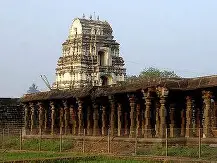East Godavari, Andhra Pradesh: Draksharamam, also known as Daksharamam, holds a unique place in India’s religious and cultural landscape. Revered as one of the five Pancharama Kshetras dedicated to Lord Shiva and recognized as the 12th of the Ashtadasha Shakti Peetams, the temple complex continues to be a significant pilgrimage destination for devotees across the country.
The site is steeped in history and mythology. The Bhimeswara Swamy temple, constructed during the Eastern Chalukyan period in the 9th century CE, stands as a major architectural landmark. Built in stone with intricate carvings, the temple showcases the craftsmanship of early South Indian temple builders. It is believed that the temple was expanded further under the patronage of the Chola and Kakatiya dynasties, each leaving their imprint on the structure.
Draksharamam is also associated with the legend of Daksha Yagna, a pivotal episode in Hindu mythology. According to tradition, when Goddess Sati immolated herself at the sacrificial fire of her father Daksha, parts of her body are said to have fallen at various places that became the Shakti Peetams. Draksharamam is identified as the site where her left cheek fell, making it one of the most sacred centres of Shakti worship.
The temple is not only a place of worship but also a hub of cultural activity. Festivals such as Maha Shivaratri and Navaratri draw thousands of devotees, with rituals and celebrations continuing late into the night. The temple’s dual significance—as a Shaivite and Shakti shrine—has made it a rare confluence of traditions within Hinduism.
Today, Draksharamam is maintained under the Endowments Department of Andhra Pradesh, with efforts to balance preservation of its heritage architecture and facilitation of modern pilgrim amenities. The site has also been proposed for recognition under heritage tourism circuits, given its architectural and religious importance.
Draksharamam remains a testament to India’s enduring spiritual traditions, serving both as a place of deep devotion and as a living monument of cultural history. Its unique identity as both a Pancharama Kshetra and a Shakti Peetam ensures that it continues to be a focal point of religious life in the region.
Also read:Why India’s Swadeshi Push Makes Zoho More Than Just a Homegrown SaaS Tool

